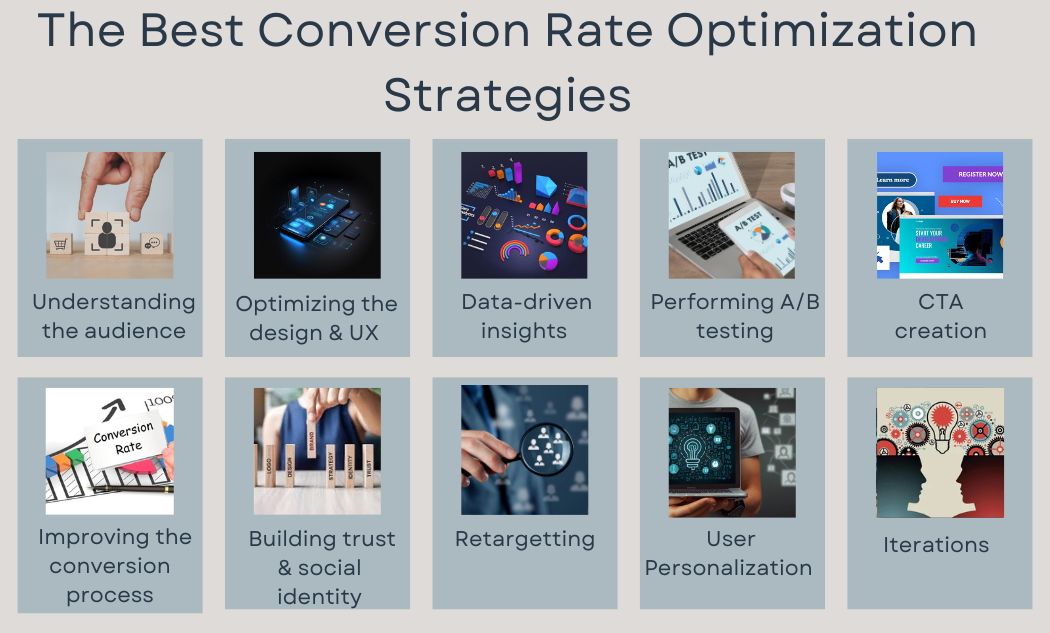Boost Your Bottom Line: Proven Techniques for Conversion Rate Optimization

Table of ContentsToggle Table of ContentToggle
In this competitive market, conversion rate optimisation (CRO). It is the key structure for maximising the website’s potential for the market. To drive the attention of the audience is just 50% of the battle. The important part is to convert these visitors. The aim is to increase the engagement & audience to lead. Or loyal followers or customers.
This blog will let you know about the conversion rate optimization strategies. This tells the best practices to optimize the conversions. Of the particular site. Like for an e-commerce store or any other business. The CRO best practices help in achieving the goals.
What do you mean by Conversion Rate Optimisation (CRO)?
The conversion rate optimization (CRO) is the process of increasing the rates. The percentage of visitors. Who acts on the website, like clicking for a buy or calling? It is treated as the core component. The CRO is used for understanding the user behavior.
Key points of conversion marketing, such as analyzing, enhancing the experiences, and testing. All the elements, like CTA, content, headings, and navigation.
Why is CRO important for marketing strategies?
- Maximizing the ROI: CRO helps to improve values from the traffic. This boosts the ROI. Without increasing the market expenditure.
- Improving the User Experience: Improves the functionality of the website. To increase the conversions.
- Generating the Revenue: Little bit improvement in the conversion rates. May improve the revenue.
- Competite Edging: A fully optimized website helps in improving the visibility. Also rank among competitive marketers. .
How to improve the conversion rates
The conversion rate optimisation (CRO) is the process of increasing the rates. The percentage of visitors. Who acts on the website, like clicking for a buy or calling? It is treated as the core component. The CRO is used for understanding the user behavior.
Key points of conversion marketing, such as analyzing, enhancing the experiences, and testing. All the elements, like CTA, content, headings, and navigation.
What is a good conversion rate?
For checking this, follow:
E-commerce website: its 2-4%
B2B business: 2-5%
SaaS business: 4-7%
Financial business:5-10%
Healthcare business-3-4%
Calculation of conversion rate
For calculating the conversion rate:
Conversion Rate= (Conversion / Total number of visitors)*100
Like: 100 visitors out of 1000 purchase an item. So, 100/1000*100. The conversion rate is 10%. This is known as the conversion rate marketing. This also helps in identifying the areas for improvement.
The Best Conversion Rate Optimization Strategies

The conversion rate optimization (CRO) is the process of increasing the rates. The percentage of visitors. Who acts on the website, like clicking for a buy or calling? It is treated as the core component. The CRO is used for understanding the user behavior.
Key points of conversion marketing, such as analyzing, enhancing the experiences, and testing. All the elements, like CTA, content, headings, and navigation.
The conversion marketing helps in understanding the target audiences.
We can use tools like Google Analytics. We can also use the social media insights to find the data. Like the demographics, age, location, etc.
Conversion rate marketing provides ideas of customers. Like the pain points, objectives, and goals. Setting up the website according to the needed audience. It helps optimize a site for conversions.
The conversion marketing helps in understanding the target audiences.
We can use tools like Google Analytics. We can also use the social media insights to find the data. Like the demographics, age, location, etc.
Conversion rate marketing provides ideas of customers. Like the pain points, objectives, and goals. Setting up the website according to the needed audience. It helps optimize a site for conversions.
A user-experience design helps in marketing conversion rate optimization. Some of the points need to follow are:
Mobile/User responsiveness:
The mobile devices help to drive more traffic. Always ensure that the website is optimized on all the devices.
Loading time:
The loading time of the website should be low. For example, less than 2 seconds. So that the users don’t get irritated. It may also increase the bounce rate of the website.
Clear navigation: Try to create simple or elegant menus. So that it becomes easy for the user to navigate.
A/B testing helps in comparing 2 web pages. Explain with:
CTA button
Headlines & Ad Copies
Page Layout & Color Contrast.
It is the CRO best practices. Which helps in taking the decisions in the future.
The CTA is treated as the top point of the conversion marketing. The key points to follow while writing CTA:
Action: The action needs to be clear. So, that user can know what step they need to take. Such as “Call Today.” or “Get Started.”.
Data Accuracy: The CTA of the page should align. With the content of the page.
Visibility: The CTA should be placed in the right place. Easy for users to look for.
The complex process makes the process complex. Same like any e-commerce site; ask for some details. The guest checkout helps in future buying processes.
Creating Your CRO Strategy
CRO helps in monitoring the performance metrics. Testing the strategies & adapting them.
Selecting the CRO Tools
Avoid These Mistakes: To Improve CRO
The Role of SEO in Conversion Rate Optimisation
The SEO & CRO work simultaneously. TO drive the sales & conversion. The CRO helps in converting traffic. And SEO helps in generating traffic to the website. It is a successful conversion rate optimization strategies.
Tips to follow in SEO & CRO
Using high-intent keywords to increase conversion rate.
Optimizing the descriptions & meta title.
It improves the visibility & engagement rate.
Real-Time Case Study: CRO Success Story
A e-commerce business using CRO best practice. They optimize the navigation & check-out process. They also perform A/B testing on the website & landing page. This helps in increasing the 30-40% increase in conversions.
This states the powerful conversion rate optimisation strategies. This shows how well the business is optimized.
The Best Conversion Rate Optimization Strategies for E-commerce
The e-commerce website & product page optimisation. With conversion rate marketing strategy. Enhancing the product pages for improvement. In the e-commerce business. The product page is like a cherry on top of the cake. As it is seen, like the sales funnel, is the bread and butter. For the e-commerce business. To increase the engagement and conversion of the pages. Some of the best conversion rate optimization strategies to be followed are:
The e-commerce website & product page optimisation. With conversion rate marketing strategy. Enhancing the product pages for improvement. In the e-commerce business. The product page is like a cherry on top of the cake. As it is seen, like the sales funnel, is the bread and butter. For the e-commerce business. To increase the engagement and conversion of the pages. Some of the best conversion rate optimization strategies to be followed are:
The page speed is related to the user experience. The slow loading of the product page may decrease the conversion rates. Fast loading is treated as the best strategy. The best conversion rate optimization strategies.
Splitting of the testing for the product pages. Like for images, videos, etc. CTA, description, and title are also it’s parts. Regular testing needs to be performed for better results.
By choosing these elements. We can improve conversion rate optimisation strategies. This helps to maximize the visitors of the site
Boosting the conversion with best Landing page strategy

The LP is treated as the first impression for the users. After viewing the landing page, the customer decides. Whether they need to move forward or exit from the page. A landing page that is not properly optimized. It resulted in losing an opportunity for the owners. With the best conversion rate optimisation strategies. This helps to achieve the goals of the business to create visibility.This helps to increase the performance of the website. Some of the steps that need to be followed are:
Creating a value proposition:
The landing page highlights the benefits of the products. It helps the users take the desired action according to the need. The strong value proposition helps to improve the conversion marketing outcomes.
Optimizing the devices:
Optimizing on all devices. Mobile brings the major traffic to the website. So the business website should be optimized. We need to ensure that the landing page follows some points. Like responsiveness, loading speed, & clear CTA. The conversion rate optimization strategies need to be followed fully. It’s mandatory to be followed. It helps in bring or attracting more audience to the website
Improving social visibility:
Improving social media visibility. It helps in gaining more trust from the users. Like asking customers to provide reviews & testimonials. So that it can be used on the landing page for trust. It helps in gaining the conversion rate in marketing.
Simplifying the user experience:
Using minimum elements on the landing page. So that it does not distract the user. It helps to simplify the CRO best practices.
Testing & measuring the performance:
Testing the different elements of LP with the help of split testing. Experimenting with the headlines, CTAs, & layouts. This helps to identify the best working. Which is more relevant to the audience?
By using the conversion rate optimization strategies. It helps to gain more engagement on the landing page.
Measuring the CRO Efforts
Tracking the metrics for more effective use of the conversion rate optimisation strategies are:
Measuring the conversion rate:
The increase or decrease in the percentages of the visitors. Need to record the conversion rate of the visitors. So that the data of the visitor is collected according to the decision of the business.
Average order value (AOV):
For the e-commerce site, higher AOV is the success of the product page.
Time spent on page:
The increase in the time spent on the pages. Higher the chance of conversion.
By regularly monitoring these metrics, you can refine your approach and continuously improve your conversion marketing efforts.
Conversion rate optimisation, or CRO. It is an excellent tool for a business seeking to maximize the effectiveness of a website. And thus create more revenue without increased traffic. A key strategy in boosting the conversion rate. It is the use of mobile optimization, split testing, user navigation, and CTAs.
Conversion rate marketing is a process that continues on in an ongoing manner. Continuous testing, optimisation, and refinement of your website. It leads to more conversions and increases your ROI. Optimizing your conversion rate helps build a better website. For your audience while making the most out of your business’s bottom line.
By continuous improvement and the implementation of these best CRO practices. You will be able to create a website. That is both user-responsive and optimized for the highest possible conversion rates.
About Author

Written By Daksh Upadhyay
Daksh, is an experienced Frontend developer with a passion for social media marketing and writing technical content. With more than 4 years of experience in the development industry, his expertise lies in UX and UI designing, Tailwind, and Bootstrap. When not coding, Daksh enjoys staying up-to-date with the latest trends in social media marketing and technology. He also enjoys sharing his knowledge with young, aspiring developers.




